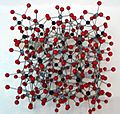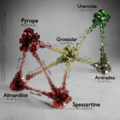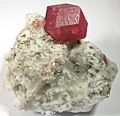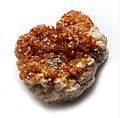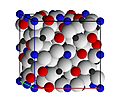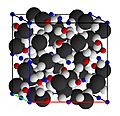Garnet facts for kids
Quick facts for kids Garnet |
|
|---|---|
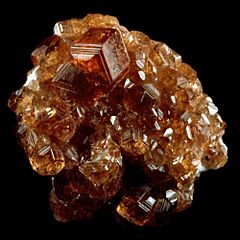 |
|
| General | |
| Category | Nesosilicate |
| Formula (repeating unit) |
The general formula X3Y2(SiO4)3 |
| Identification | |
| Color | virtually all colors, blue very rare |
| Crystal habit | Rhombic dodecahedron or cubic |
| Cleavage | Indistinct |
| Fracture | conchoidal to uneven |
| Mohs scale hardness | 6.5–7.5 |
| Luster | vitreous to resinous |
| Streak | White |
| Specific gravity | 3.1–4.3 |
| Polish luster | vitreous to subadamantine |
| Optical properties | Single refractive, often anomalous double refractive |
| Refractive index | 1.72–1.94 |
| Birefringence | None |
| Pleochroism | None |
| Ultraviolet fluorescence | variable |
| Other characteristics | variable magnetic attraction |
| Major varieties | |
| Pyrope | Mg3Al2Si3O12 |
| Almandine | Fe3Al2Si3O12 |
| Spessartine | Mn3Al2Si3O12 |
| Andradite | Ca3Fe2Si3O12 |
| Grossular | Ca3Al2Si3O12 |
| Uvarovite | Ca3Cr2Si3O12 |
A garnet is a fascinating type of silicate mineral, which means it's made mostly of silicon and oxygen, along with other elements. These beautiful crystals are known for their wide range of colors and are often used in jewelry. While many people think of garnets as red, they can actually be found in almost every color of the rainbow, though blue is extremely rare. Garnet is also the special birthstone for people born in January.
Contents
What Are Garnets Made Of?
Garnets are not just one single mineral; they are a group of minerals that share a similar crystal structure. Think of them like a family of minerals! Each member of the garnet family has a slightly different chemical recipe.
For example, some common types include:
- Pyrope: This type often has a deep red color. It contains magnesium and aluminum.
- Almandine: This is another common red to reddish-brown garnet, rich in iron and aluminum.
- Spessartine: This garnet can be orange, reddish-orange, or even yellowish-brown. It contains manganese and aluminum.
- Andradite: This type can show a variety of colors, including yellow, green, brown, or black. It contains calcium and iron.
- Grossular: This garnet is often green, yellow, or cinnamon-brown. It contains calcium and aluminum. A bright green variety called tsavorite is very popular.
- Uvarovite: This is a rare and striking bright green garnet, containing calcium and chromium.
Even though their chemical makeup varies, all garnets share a similar basic formula: X3Y2(SiO4)3. The 'X' and 'Y' spots are where different metals like iron, magnesium, calcium, or manganese can fit in.
Where Do Garnets Come From?
Garnets form deep inside the Earth under intense heat and pressure. They are often found in metamorphic rocks, which are rocks that have changed due to these extreme conditions. You can find garnets in many places around the world, including parts of the United States, India, Brazil, and Africa.
How Are Garnets Used?
Garnets have been admired and used by humans for thousands of years.
- Jewelry: Their beauty and durability make them perfect for rings, necklaces, and other ornaments. Ancient civilizations, like the Anglo-Saxons, used garnets in intricate designs, sometimes set in gold.
- Industrial Uses: Because garnets are quite hard (scoring 6.5 to 7.5 on the Mohs scale of mineral hardness), they are also used for things like sandpaper, waterjet cutting, and abrasive blasting. Their toughness makes them great for grinding and polishing.
Fun Facts About Garnets
- Garnets are known for their luster, which describes how light reflects off their surface. They can look shiny like glass (vitreous) or even like resin.
- The word "garnet" comes from the Latin word "granatus," meaning "grain" or "seed," likely because some garnets look like the small, red seeds of a pomegranate.
- While red is the most common color, some rare garnets can even change color depending on the light!
See Also
Images for kids
-
Grossular on display at the U.S. National Museum of Natural History. The green gem at right is a type of grossular known as tsavorite.
-
c. 8th century AD, Anglo-Saxon sword hilt fitting – gold with gemstone inlay of garnet cloisonné. From the Staffordshire Hoard, found in 2009, and not fully cleaned.
More Information
 In Spanish: Granate (mineral) para niños
In Spanish: Granate (mineral) para niños



